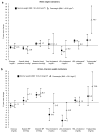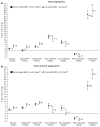Changes in risk factors for cardiovascular disease by baseline weight status in young adults who maintain or gain weight over 15 years: the CARDIA study
- PMID: 16534519
- PMCID: PMC3234682
- DOI: 10.1038/sj.ijo.0803307
Changes in risk factors for cardiovascular disease by baseline weight status in young adults who maintain or gain weight over 15 years: the CARDIA study
Abstract
Objectives: To examine whether changes in cardiovascular disease (CVD) risk factors differ by baseline weight status among young adults who maintained or gained weight.
Design: Longitudinal cohort study.
Subjects: White and African Americans who either maintained (+/-5 pounds; n=488) or gained (>5 pounds; n=2788) weight over 15 years.
Measurements: Anthropometrics and CVD risk factors were measured at baseline (1985-1986) and follow-up. Participants were classified as normal weight (body mass index (BMI) 18.5-24.9 kg/m2) or overweight (BMI >or=25 kg/m2) at baseline. Multivariable models were stratified by ethnicity and weight change category.
Results: Normal weight maintainers tended to have more favorable risk factors at baseline and follow-up than overweight maintainers. Size and direction of 15-year changes in risk factors were similar by weight status, except that in white normal weight maintainers changes in high-density lipoprotein (HDL)-cholesterol (3.3 mg/dl (95% confidence interval (CI): 0.4, 6.3)) and triglycerides (-14.7 mg/dl (-25.8, -3.7)) were more favorable. Weight gain was associated with unfavorable changes in risk factors. Weight gainers normal weight at baseline had less adverse changes in glucose, blood pressure, HDL-cholesterol (whites only) and triglycerides (African Americans only) than overweight gainers. However, normal weight African-American weight gainers had more adverse changes in total (3.1 mg/dl (0.2, 6.1)) and low-density lipoprotein-cholesterol (3.4 mg/dl (0.6, 6.3)).
Conclusions: Baseline weight status does not appear to influence the size or direction of risk factor changes among adults who maintained their weight over 15 years. In contrast, weight gain was associated with changes in some risk factors differentially by baseline weight status.
Figures


References
-
- Mokdad AH, Bowman BA, Ford ES, Vinicor F, Marks JS, Koplan JP. The continuing epidemics of obesity and diabetes in the United States. JAMA. 2001;286:1195–1200. - PubMed
-
- National Institutes of Health. National Heart Lung and Blood Institute: clinical guidelines on the identification, evaluation, and treatment of overweight and obesity in adults. The Evidence Reports. Obes Res. 1998;6:53S. - PubMed
-
- Miller MC. How effective are traditional dietary and exercise interventions for weight loss? Med Sci Sports Exerc. 1999;31:1129–1131. - PubMed
-
- Williamson DF, Kahn HS, Remington PL, Anda RF. The 10-year incidence of overweight and major weight gain in US adults. Arch Intern Med. 1990;150:655–672. - PubMed
-
- Rissanen A, Heliovaara M, Aromaa A. Overweight and anthropometric changes in adulthood: a prospective study of 17 000 Finns. Int J Obes Relat Metab Disord. 1988;12:391–401. - PubMed
MeSH terms
Substances
Grants and funding
LinkOut - more resources
Full Text Sources
Medical
Molecular Biology Databases

